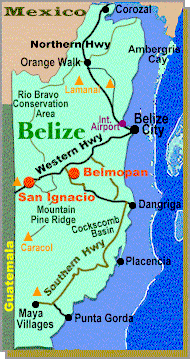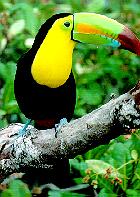

Central America's Belize is situated south of Mexico's Yucatan Peninsula, directly east of Guatemala and north of Honduras.  Its eastern Caribbean side is bordered by a 283 kilometer (176 mile) coral barrier reef which is the longest in the Western Hemisphere and the second largest in the world. The sub-tropical climate is tempered by trade winds with temperatures in coastal areas ranging from approximately 10C (50F) to about 35C (95F). Inland temperatures which are less moderated by the Caribbean Sea tend to fluctuate to a greater degree. Rainfall varies extremely from an average of 50 inches in the north to 180 inches in the south. Travelers should note that the dry season usually extends from February to May with a another potential dry spell in August.
Its eastern Caribbean side is bordered by a 283 kilometer (176 mile) coral barrier reef which is the longest in the Western Hemisphere and the second largest in the world. The sub-tropical climate is tempered by trade winds with temperatures in coastal areas ranging from approximately 10C (50F) to about 35C (95F). Inland temperatures which are less moderated by the Caribbean Sea tend to fluctuate to a greater degree. Rainfall varies extremely from an average of 50 inches in the north to 180 inches in the south. Travelers should note that the dry season usually extends from February to May with a another potential dry spell in August.
A traveler to Belize requires a valid passport, however, any citizen of the United States, Canada, Mexico, Costa Rica, the European Community and the British Commonwealth (excluding India) does not also require a visa for travel to Belize. And since no epidemics are prevalent in Belize, booster shots are not required. Nevertheless, a traveler would be wise to receive inoculations for hepatitis A and B, typhoid and tetanus prior to departure. Furthermore, malaria pills should be taken along as an additional precaution.
The Belizean currency is the Belize dollar (BZ$) which is fixed at a rate of exchange of BZ$2 to US$1. Four (4) commercial banks, namely, Belize Bank, Barclays Bank, Atlantic Bank and the Bank of Nova Scotia operate in Belize. Also, a satellite earth station in the capital city of Belmopan provides high quality telecommunications with the outside world. Most electricity is provided by diesel generating equipment powered at 110 volts AC (as in the United States and Canada). It is recommended that travelers take a small surge suppressor for computers and other sensitive electronic equipment.
 Today the country's main industries still consist of sugar, citrus, fisheries and bananas. Sugar alone accounts for more than 33.4% of the country's foreign exchange earnings. However, major efforts are being made to diversify from this commodity-based economy.
Today the country's main industries still consist of sugar, citrus, fisheries and bananas. Sugar alone accounts for more than 33.4% of the country's foreign exchange earnings. However, major efforts are being made to diversify from this commodity-based economy.
Estimates put Belize's small easy-going harmonious multi-racial population (consisting of a mixture of Creole, Garifuna, Spanish, Maya, English, Mennonite, Lebanese, Chinese and Eastern Indian) at about 220,000+ with approximately 58,000 living in Belize City and 12,000 resident in each of Orangewalk Town and San Ignacio/Santa Elena. Although english is the official language and the language of instruction in schools, spanish is also widely spoken. A recent census indicated that 76.7% of the Belizean population (predominantly in coastal and central areas) is somewhat to very fluent in english in contrast to 55.0% of the populus (primarily in northern and western border areas) that is somewhat to very fluent in spanish.
Historically, Belize (then still named British Honduras) was formally declared a British Colony in 1871. As a democracy, Belize achieved full independence on September 21, 1981. It is currently a member of the British Commonwealth, the United Nations, the Organization of American States (OAS) and the newly formed Association of Caribbean States.
For more information about Belize, please refer to the excellent revised paperback book, "Belize, A Guide to Business Investment and Retirement" ISBN 0965649407 published in 1996 by OffShore Consultants of Southwest Florida Incorporated and to the 4th edition paperback "Belize Handbook" by Chicki Mallan ISBN 1566911370 published in 1998 by Publishers Group West Incorporated. Both of these titles can be obtained from either Amazon Books in the U.S. or ChaptersIndigo Books in Canada.
|
Please visit one of my other travel-related pages:
|
||||
|
ME, MUSIC & TRAVEL
|
MY MARGARITAVILLE
|
N'AWLINS LINKS
|
LET'S TRAVEL TOGETHER
|
SCENIC NFLD CA
|
If you are unfamiliar with Belize, please take the EXCELLENT Belize Districts Virtual Tour!
This page was initially created on August 8, 1999.